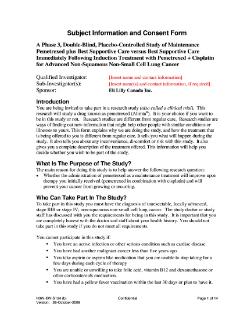
Informed consent is a principle in medical ethics and medical law that a patient should have sufficient information before making their own free decisions about their medical care. A healthcare provider is often held to have a responsibility to ensure that the consent that a patient gives is informed, and informed consent can apply to a health care intervention on a person, conducting some form of research on a person, or for disclosing a person's information. A health care provider may ask a patient to consent to receive therapy before providing it, a clinical researcher may ask a research participant before enrolling that person into a clinical trial, and a researcher may ask a research participant before starting some form of controlled experiment. Informed consent is collected according to guidelines from the fields of medical ethics and research ethics.
A patient's bill of rights is a list of guarantees for those receiving medical care. It may take the form of a law or a non-binding declaration. Typically a patient's bill of rights guarantees patients information, fair treatment, and autonomy over medical decisions, among other rights.
In developmental psychology and moral, political, and bioethical philosophy, autonomy is the capacity to make an informed, uncoerced decision. Autonomous organizations or institutions are independent or self-governing. Autonomy can also be defined from a human resources perspective, where it denotes a level of discretion granted to an employee in his or her work. In such cases, autonomy is known to generally increase job satisfaction. Self-actualized individuals are thought to operate autonomously of external expectations. In a medical context, respect for a patient's personal autonomy is considered one of many fundamental ethical principles in medicine.
Medical ethics is an applied branch of ethics which analyzes the practice of clinical medicine and related scientific research. Medical ethics is based on a set of values that professionals can refer to in the case of any confusion or conflict. These values include the respect for autonomy, non-maleficence, beneficence, and justice. Such tenets may allow doctors, care providers, and families to create a treatment plan and work towards the same common goal. It is important to note that these four values are not ranked in order of importance or relevance and that they all encompass values pertaining to medical ethics. However, a conflict may arise leading to the need for hierarchy in an ethical system, such that some moral elements overrule others with the purpose of applying the best moral judgement to a difficult medical situation. Medical ethics is particularly relevant in decisions regarding involuntary treatment and involuntary commitment.

Life support refers to the treatments and techniques performed in an emergency in order to support life after the failure of one or more vital organs. Healthcare providers and emergency medical technicians are generally certified to perform basic and advanced life support procedures; however, basic life support is sometimes provided at the scene of an emergency by family members or bystanders before emergency services arrive. In the case of cardiac injuries, cardiopulmonary resuscitation is initiated by bystanders or family members 25% of the time. Basic life support techniques, such as performing CPR on a victim of cardiac arrest, can double or even triple that patient's chance of survival. Other types of basic life support include relief from choking, staunching of bleeding by direct compression and elevation above the heart, first aid, and the use of an automated external defibrillator.
Confidentiality involves a set of rules or a promise usually executed through confidentiality agreements that limits access or places restrictions on certain types of information.
A medical error is a preventable adverse effect of care ("iatrogenesis"), whether or not it is evident or harmful to the patient. This might include an inaccurate or incomplete diagnosis or treatment of a disease, injury, syndrome, behavior, infection, or other ailment. Globally, it is estimated that 142,000 people died in 2013 from adverse effects of medical treatment; this is an increase from 94,000 in 1990. However, a 2016 study of the number of deaths that were a result of medical error in the U.S. placed the yearly death rate in the U.S. alone at 251,454 deaths, which suggests that the 2013 global estimation may not be accurate. In line with the high importance of the research area, a 2019 study identified 12,415 scientific publications related to medical errors, and outlined as frequently researched and impactful themes errors related to drugs/medications, applications related to medicinal information technology, errors related to critical/intensive care units, to children, and mental conditions associated with medical errors.

The terms medical record, health record and medical chart are used somewhat interchangeably to describe the systematic documentation of a single patient's medical history and care across time within one particular health care provider's jurisdiction. A medical record includes a variety of types of "notes" entered over time by healthcare professionals, recording observations and administration of drugs and therapies, orders for the administration of drugs and therapies, test results, x-rays, reports, etc. The maintenance of complete and accurate medical records is a requirement of health care providers and is generally enforced as a licensing or certification prerequisite.
At common law, battery is a tort falling under the umbrella term 'Trespass to the person'. Entailing unlawful contact which is directed and intentional, or reckless and voluntarily bringing about a harmful or offensive contact with a person or to something closely associated with them, such as a bag or purse, without legal consent.
Male circumcision is the surgical removal of the foreskin (prepuce) from the human penis. The ethics of circumcision in neonates and children is a source of much controversy.
The medical history, case history, or anamnesis of a patient is information gained by a physician by asking specific questions, either of the patient or of other people who know the person and can give suitable information, with the aim of obtaining information useful in formulating a diagnosis and providing medical care to the patient. The medically relevant complaints reported by the patient or others familiar with the patient are referred to as symptoms, in contrast with clinical signs, which are ascertained by direct examination on the part of medical personnel. Most health encounters will result in some form of history being taken. Medical histories vary in their depth and focus. For example, an ambulance paramedic would typically limit their history to important details, such as name, history of presenting complaint, allergies, etc. In contrast, a psychiatric history is frequently lengthy and in depth, as many details about the patient's life are relevant to formulating a management plan for a psychiatric illness.

Bolam v Friern Hospital Management Committee [1957] 1 WLR 582 is an English tort law case that lays down the typical rule for assessing the appropriate standard of reasonable care in negligence cases involving skilled professionals such as doctors. This rule is known as the Bolam test, and states that if a doctor reaches the standard of a responsible body of medical opinion, they are not negligent. Bolam was rejected in the 2015 Supreme Court decision of Montgomery v Lanarkshire Health Board.
The doctor–patient relationship is a central part of health care and the practice of medicine. A doctor–patient relationship is formed when a doctor attends to a patient's medical needs and is usually through consent. This relationship is built on trust, respect, communication, and a common understanding of both the doctor and patients' sides. The trust aspect of this relationship goes is mutual, the doctor trusts the patient to reveal any information that may be relevant to the case and in turn, the patient trusts the doctor to respect their privacy and not disclose this information to outside parties.
Informed refusal is where a person has refused a recommended medical treatment based upon an understanding of the facts and implications of not following the treatment. Informed refusal is linked to the informed consent process, as a patient has a right to consent, but also may choose to refuse.
Sidaway v. Board of Governors of the Bethlem Royal Hospital [1985] AC 871 is an important House of Lords case in English tort law, specifically medical negligence, concerning the duty of a surgeon to inform a patient of the risks before undergoing an operation.
The Health Care Consent Act (HCCA) is an Ontario law that has to do with the capacity to consent to treatment. See also: informed consent. The HCCA states that a person has the right to consent to or refuse treatment if they have mental capacity. In order to have capacity, a person must have the "ability" to understand and appreciate the consequences of the treatment decision. The law says that “a person is capable with respect to a treatment, admission to a care facility or a personal assistance service if the person is able to understand the information that is relevant to making a decision about the treatment, admission or personal assistance service, as the case may be, and able to appreciate the reasonably foreseeable consequences of a decision or lack of decision”.
Medical malpractice is a legal cause of action that occurs when a medical or health care professional, through a negligent act or omission, deviates from standards in their profession, thereby causing injury to a patient. The negligence might arise from errors in diagnosis, treatment, aftercare or health management.
Canterbury v. Spence was a landmark federal case decided by the United States Court of Appeals for the District of Columbia Circuit that significantly reshaped malpractice law in the United States. It established the idea of "informed consent" to medical procedures.

Montgomery v Lanarkshire Health Board [2015] UKSC 11 is a Scottish delict, medical negligence and English tort law case on doctors and pharmacists that outlines the rule on the disclosure of risks to satisfy the criteria of an informed consent. The Supreme Court departed and overruled the earlier House of Lords case in Sidaway v Board of Governors of the Bethlem Royal Hospital, in reconsidering the duty of care of a doctor towards a patient on medical treatment. The case changed the Bolam test to a greater test in medical negligence by introducing the general duty to attempt the disclosure of risks.

Salgo v. Leland Stanford Jr. University Board of Trustees was a 1957 court case that helped to establish what the practice of informed consent was supposed to look like in the practice of modern medicine. This was evaluated with respect to the California Court of Appeals case where Martin Salgo sued the trustees of Stanford University and Stanford physician Dr. Frank Gerbode for malpractice as he claimed that they did not inform him nor his family of the details and risks associated with an aortogram which left him permanently paralyzed in his lower extremities.






